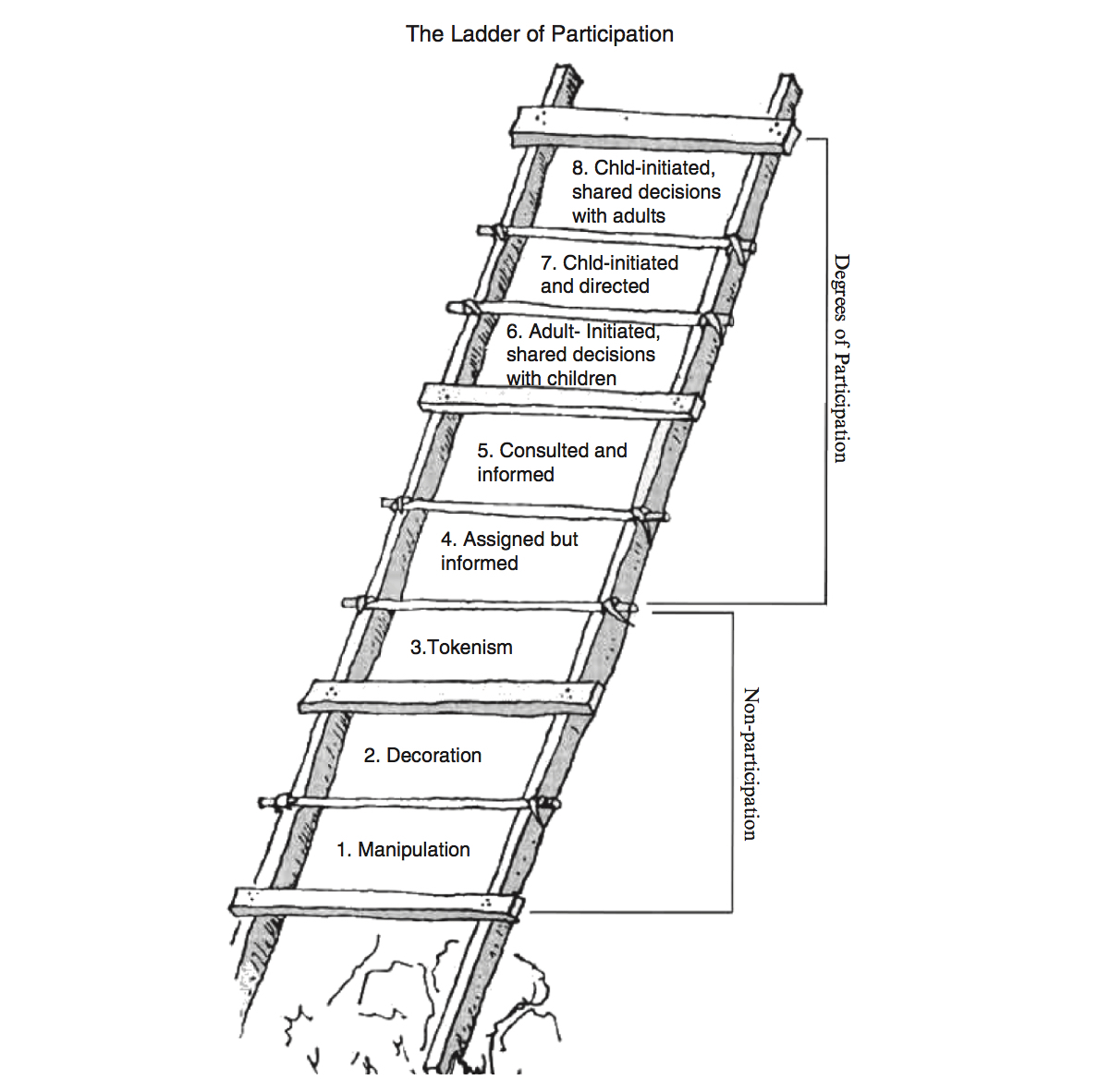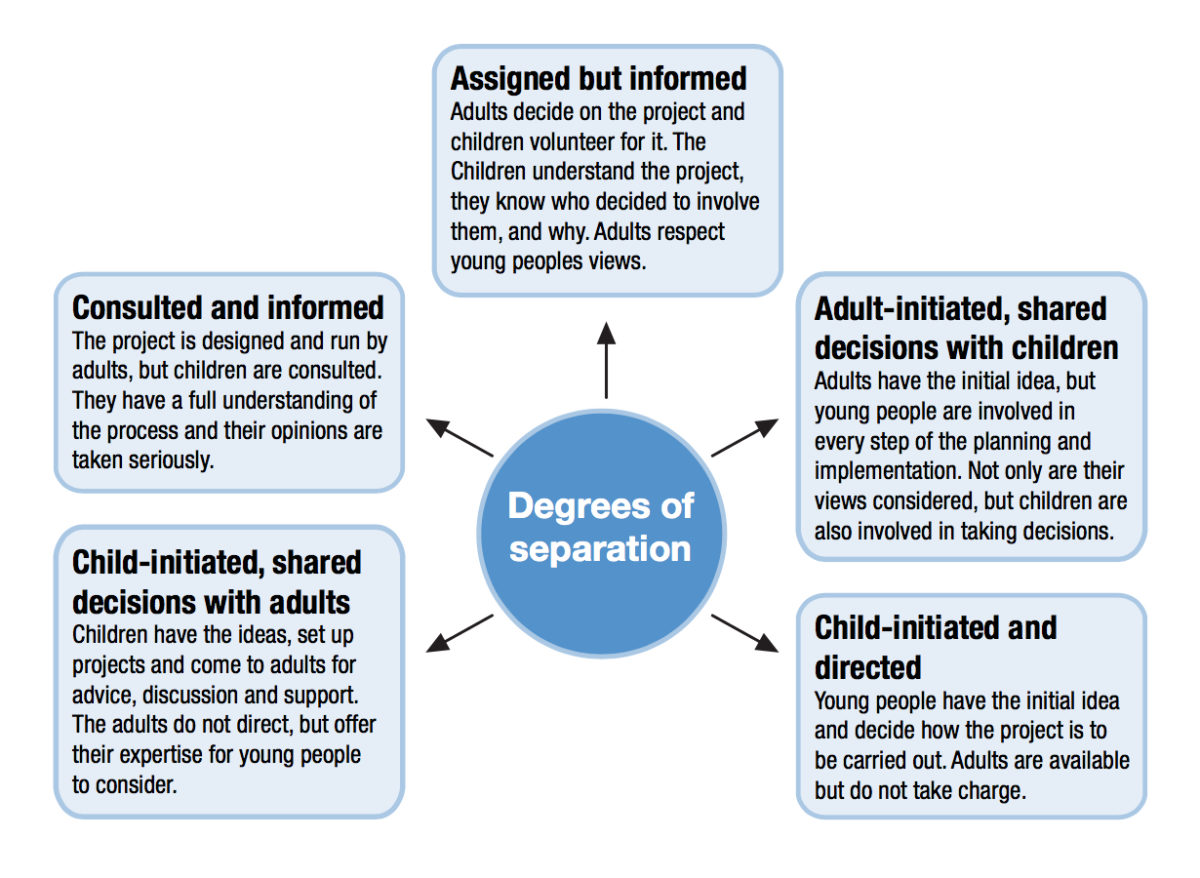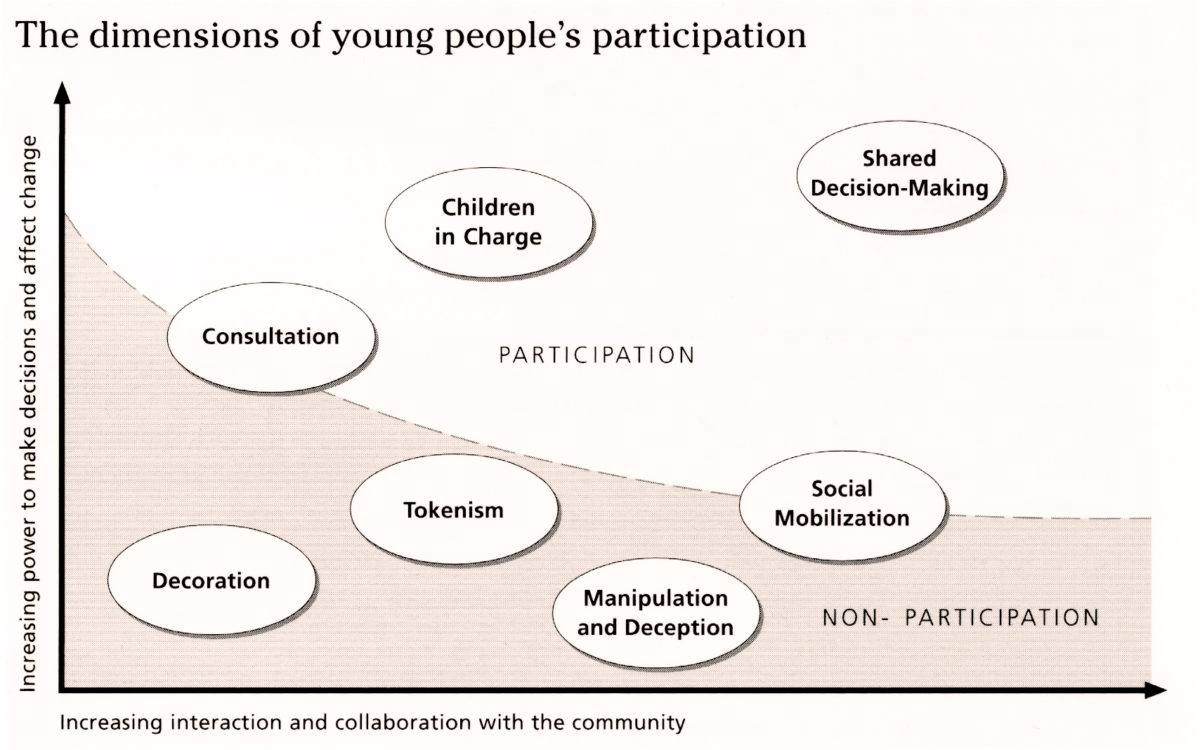Hum 4956 Arts for Health Peace and Community Engagement in Northern Ireland
Commencement published in Children'due south Participation: From Tokenism to Citizenship , a 1992 publication of the International Child Evolution Center of the United Nations Children's Fund (UNICEF), Roger Hart's Ladder of Children's Participation applied the conceptual framework of Sherry Arnstein's Ladder of Citizen Participation to the participation of children in adult projects, programs, and activities, including forms of work, advocacy, and citizenship. Like Arnstein'due south earlier framework, Hart'southward modified ladder of participation became an influential and widely practical model in the fields of child development, education, civic participation, and democratic decision-making.
"Young people's participation cannot be discussed without considering power relations and the struggle for equal rights. It is important that all young people take the opportunity to learn to participate in programmes which directly bear upon their lives. This is especially and then for disadvantaged children for through participation with others such children larn that to struggle confronting discrimination and repression, and to fight for their equal rights in solidarity with others is itself a fundamental democratic right…. The highest possible degree of citizenship in my view is when we, children or adults, non just feel that we tin initiate some change ourselves simply when we too recognise that it is sometimes appropriate to also invite others to join the states because of their own rights and because it affects them too, as fellow-citizens."
Roger A. Hart, Children'south Participation: From Tokenism to Citizenship
In 2008, Hart explained his rationale for developing the model:
"The ladder was simply offered every bit a schema to aid bring a critical perspective to a subject that at that time birthday lacked one…. The most benign quality of the model has probably been its utility for helping dissimilar professional person groups and institutions to rethink how they piece of work with immature people: youth workers, television and radio directors, scout leaders, play workers, street workers, health professionals, and even some schoolhouse teachers. Its simplicity of course and clarity of goals enable them to discover a language to look at their current ways of working systemically, and in so doing, come with something more circuitous and useful to their item context."

The Ladder of Children's Participation
Hart's typology of children'southward participation is presented as a metaphorical "ladder," with each ascending rung representing increasing levels of child agency, command, or ability. In addition to the eight "rungs" of the ladder represent a continuum of power that ascends from nonparticipation (no agency) to degrees of participation (increasing levels of agency). It should be noted that Hart's use of the term "children" encompasses all legal minors from preschool-age children to adolescents.
The eight rungs of Hart'south Ladder of Children's Participation are:
ane. Manipulation
Participation as manipulation occurs when children and youth do not sympathise the bug motivating a participatory process or their function in that process. In Hart'due south words: "Sometimes adults feel that the end justifies the means…. If children take no understanding of the problems and hence do not understand their actions, so this is manipulation. Such manipulation under the guise of participation is hardly an appropriate mode to introduce children into democratic political processes."
Examples include "pre-schoolhouse children carrying political placards concerning the bear upon of social policies on children" when those children practise non understand the issues or their function in the political procedure, and asking children "to make drawings of something, such as their ideal playground," afterward which "adults collect the drawings and in some hidden manner synthesize the ideas to come up with 'the children's design' for a playground. The process of assay is not shared with the children and is usually not even made transparent to other adults. The children have no thought how their ideas were used."
2. Ornamentation
Participation every bit ornament occurs when children and youth are put on public brandish during an event, performance, or other activity organized for a specific purpose, but they exercise not empathize the pregnant or intent of their involvement.
Examples include "those frequent occasions when children are given T-shirts related to some cause, and may sing or dance at an event in such dress, but take piffling idea of what it is all about and no say in the organizing of the occasion. The young people are at that place considering of the refreshments, or some interesting operation, rather than the cause. The reason this is described as one rung upwards from 'manipulation' is that adults do non pretend that the crusade is inspired by children. They merely apply the children to eternalize their cause in a relatively indirect mode."
three. Tokenism
Participation equally tokenism occurs in "those instances in which children are patently given a voice, but in fact have lilliputian or no choice about the subject area or the style of communicating information technology, and footling or no opportunity to formulate their own opinions."
Examples include "how children are sometimes used on briefing panels. Articulate, charming children are selected by adults to sit on a console with trivial or no substantive preparation on the subject and no consultation with their peers who, information technology is implied, they stand for. If no explanation is given to the audience or to the children of how they were selected, and which children's perspectives they stand for, this is usually sufficient indication that a project is not truly an instance of participation."
4. Assigned but Informed
Participation that is assigned but informed occurs when the children and youth (i) "sympathise the intentions of the project," (2) "know who fabricated the decisions concerning their involvement and why," (3) "have a meaningful (rather than 'decorative') role," and (iv) "volunteer for the project after the projection was made clear to them."
Hart describes, as an example, a World Acme for Children held at the Un Headquarters. It was "an extremely big event with neat logistical complexity" and "it would have been difficult to involve young people genuinely in the planning of such an event," co-ordinate to Hart. However, "a child was assigned to each of the 71 earth leaders. Equally 'pages,' these children became experts on the United nations building and the upshot, and were able to play the of import function of ushering the Presidents and Prime Ministers to the right places at the right times." In this example, the children'south role was both functional and symbolic, and "the children'south roles as pages were important and were articulate to all."
five. Consulted and Informed
Participation that constitutes consulted and informed occurs when children act as "consultants for adults in a manner which has great integrity. The project is designed and run by adults, just children understand the process and their opinions are treated seriously."
One example Hart describes is of an adult-led survey of youth perceptions in which the youth are informed about the purpose of the survey, consulted almost appropriate questions before information technology'due south developed, and given an opportunity to provide feedback on the final survey before it is administered.
6. Adult-Initiated, Shared Decisions with Children
Participation that constitutes adult-initiated, shared decisions with children occurs when adults initiate participatory projects, but they share determination-making dominance or management with children.
1 instance Hart describes is a youth newspaper. In this case, the newspaper may be an adult-initiated project, simply children can manage every aspect of the operation—from reporting, writing, and editing to advertising, press, and distribution—with but guidance and technical assistance from adults.
7. Child-Initiated and Directed
Participation that is child-initiated and directed occurs when children and youth anticipate and behave out circuitous projects by working cooperatively in small-scale or large groups. While adults may observe and assist the children, they practice not interfere with the process or play a directive or managerial role.
Hart notes that it'south difficult "to find examples of child-initiated community projects. A primary reason for this is that adults are usually non adept at responding to young people'southward ain initiatives. Fifty-fifty in those instances where adults get out children alone to pattern and paint a wall mural or their own recreation room, it seems difficult for them not to play a directing function."
8. Child-Initiated, Shared Decisions with Adults
Participation that constitutes child-initiated, shared decisions with adults occurs when children—though primarily teenage youth in this case—share decision-making authority, management, or ability with adult partners and allies.
Examples would include students partnering with adults to raise funding, develop and run a school program, or pb a community campaign. A major advantage of this form of youth participation is that it tin empower immature people to have a significant impact on policies, decisions, or outcomes that were traditionally under the exclusive control and direction of adults, such as legislative or political processes.
Hart notes, nevertheless, that examples of this form of child and youth participation are rare: "The reason, I believe, is non the absence of a want to exist useful on the part of teenagers. It is rather the absenteeism of caring adults attuned to the particular interests of young people. We need people who are able to answer to the subtle indicators of energy and compassion in teenagers."

In Empowering Children and Young People: Promoting Involvement in Decision-Making (1997), Phil Treseder refashioned Roger Hart'due south Ladder of Children'south Participation into a hub-and-spoke configuration to avoid common criticisms of the ladder metaphor: in real-world settings, participation does not unfold in an ordered sequence from higher to lower, and forms of participation that appear on lower rungs of the ladder are not intrinsically worse than higher levels—in fact, they may be appropriate in sure circumstances, such as when children and youth need adult back up and guidance to fully participate in a leadership or decision-making process. Paradigm source: Empowering Young People , Carnegie United kingdom Trust, January 2008.

In Creating Better Cities with Children and Youth: A Manual for Participation (2001), David Driskell proposed another reconceptualization of Roger Hart'southward Ladder of Children's Participation called the Dimensions of Young People's Participation. The reconceived presentation places the eight rungs of Hart'southward Ladder on an Ten-Y axis. The vertical dimension illustrates increasing power to make decisions and change, while the horizontal dimension illustrates increasing levels of interaction and collaboration. Epitome source: Creating Better Cities with Children and Youth: A Manual for Participation.
Since Hart first proposed the ladder, several debates have arisen about appropriate and inappropriate applications of the framework, in part because practitioners began using the model in means that Hart never intended. Addressing a few of these debates, Hart defended a chapter to the limitations of the framework in the 2008 drove Participation and Learning , which Hart edited with colleagues:
- The ladder is intended to exist applied primarily to "programmes or projects rather than on children's everyday informal participation in their communities." As Hart writes, "The ladder of participation addresses only a rather narrow range of ways that most children in the world participate in their communities…and it is largely limited to describing the varying roles adults play in relation to children'southward participation."
- Hart besides cautions against viewing the ladder as a developmental model with sequential stages or levels of participation: "In some means the ladder metaphor is unfortunate for it seems to imply a necessary sequence to children's developing competence in participation. This was not the intention simply given the metaphor of a ladder information technology is not at all surprising that the model has been interpreted as stepwise climbing. In fact the ladder is primarily about the degree to which adults and institutions beget or enable children to participate…. I think of the upper rungs of the ladder as expressions of different 'degrees' of agency or participatory engagement by young people." (For a related discussion of the tendency to misinterpret ladder models, see Ladder of Citizen Participation.)
- The ladder is non intended to be an instrument for plan evaluation: "It is an easy step from thinking of the ladder as a developmental model to using it as a comprehensive tool to evaluate how participatory a programme is." But this application was not Hart's original intent: "There was no intention for it to serve every bit whatever kind of comprehensive evaluative tool."
- The ladder does not advocate that adults cede all power to children or that ceding power to children is always a good affair. In Hart'south words, "One of the most surprising critiques of the model for me has been the desire of some to transform the top rung of the ladder to be 'children in charge' or children's controlling without adults…. My purpose in creating this scheme had not been to fence naïvely that we should think of children as repressed individuals who needed to be liberated through a series of steps whereby all adult appointment was removed. My business organisation was rather to contend that children'south potentials equally citizens needs to be recognised to the fullest and, to that end, children ought to be able to participate at times at their highest possible level."
- Like any model, the ladder reflects some degree of cultural bias, and it may be less accurate or useful when practical to certain cultures. For case, the ladder primarily reflects a "Western orientation," which tends to emphasize individualism and the value of progressive independence and autonomy in child development, and therefore it may be less useful or fifty-fifty problematic when generically applied to cultures that emphasize the value of collectivism and the maintenance of familial or communal interdependence in child development. According to Hart, "Information technology is most surprising to me that I could not find more cultural critiques of the ladder, particularly from Asia and Africa, for I can think of some important ones. The reason may well be that many of those who write about the effect of children'south participation are themselves educated in the West and rely on Western theories of children's development which, sadly, almost completely dominates the kid development literature globally."
References
Hart, R. A. (1992). Children'due south participation: From tokenism to citizenship . Florence, Italian republic: United nations Children's Fund International Child Development Centre.
Hart, R. A. (2008). Stepping back from 'the ladder': Reflections on a model of participatory piece of work with children. In Participation and Learning: Perspectives on education and the environs, health and sustainability (pp. 19–31). Netherlands: Springer.
Creative Commons

This piece of work past Organizing Engagement is licensed under a Creative Commons Attribution-NonCommercial-ShareAlike 4.0 International License. When excerpting, adapting, or republishing content from this resource, users should cite the source texts and confirm that all quotations and excerpts are accurately presented.
salomonssaidemn1982.blogspot.com
Source: https://organizingengagement.org/models/ladder-of-childrens-participation/

0 Response to "Hum 4956 Arts for Health Peace and Community Engagement in Northern Ireland"
Post a Comment